Visual movement is used by artists to direct viewers through their work, often to a focal area.
The elements of art are often used to direct a viewer’s eye along a path through an artwork, and/or to show movement, action and direction. Also, giving some elements the ability to be moved or move on their own, via internal or external power.
In a still picture such as a painting or photograph, where nothing is actually moving, various strategies can be used to give the viewer a sense of movement and speed, or to move the viewer’s eye through the work. These include lines, diagonals and unbalanced elements; blurring; placement; direction; and motion lines and afterimages.
Movement in Painting
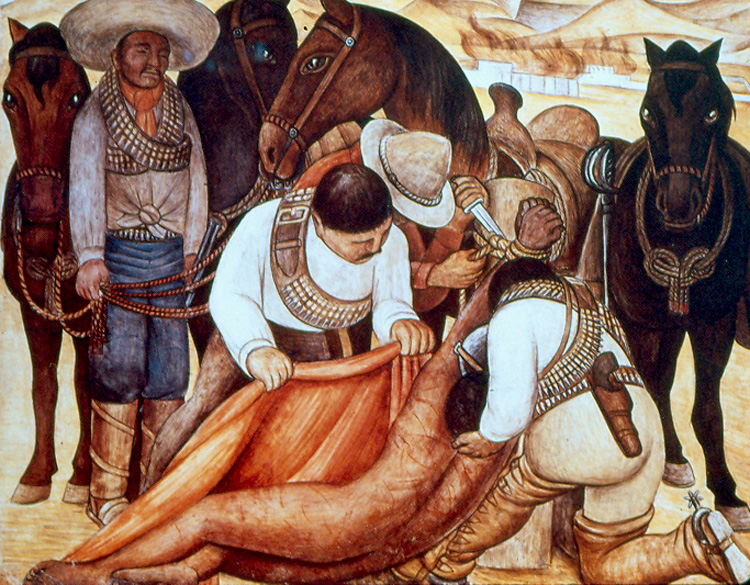
Diego Rivera – “Liberation of the Peon”, 1931
Rivera’s painting is charged with emotion and filled with history. The naked slave (peon) is being cut free from political tyranny as well as physical enslavement by the liberating soldiers. All movement leads to the focus, where a knife is cutting the binding ropes. Notice how emphasis is placed on the act of liberation rather than on the liberating heroes. Movement is also created when we observe the direction in which the human eyes are looking—directly at the peon. This causes our eyes to follow theirs, creating visual movement toward the focus. The horses look directly at us, which draws us into the grouping of figures and horses.
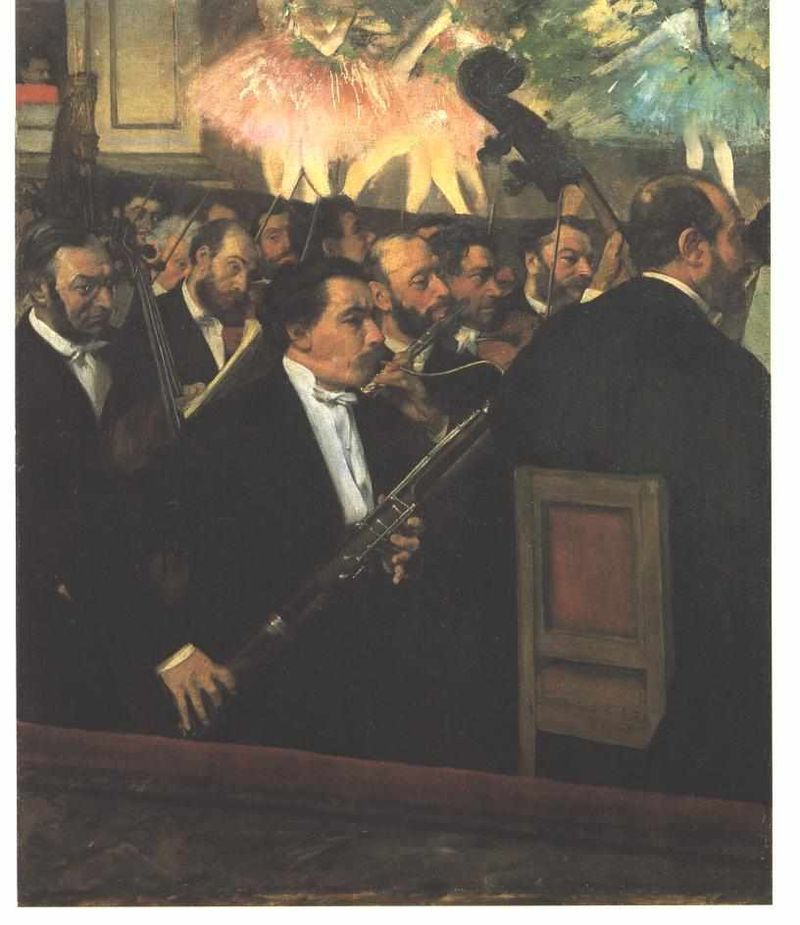 Edgar Degas, L’Orchestre de L’Opera, (1868)
Edgar Degas, L’Orchestre de L’Opera, (1868)
One of Edgar Degas most revolutionary works, L’Orchestre de l’Opera (1868) interprets forms of definite movement and gives them multidimensional movement beyond the flatness of the canvas. He positions the orchestra directly in the viewer’s space, while the dancers completely fill the background. Degas is alluding to the Impressionist style of combining movement, but almost redefines it in such a way that was seldom seen in the late 1800s. It almost seems as if a snapshot in time has been taken and at any moment members of the orchestra will be in motion, playing their instruments and the dancers in the background with continue with their production. The use of color on the dancers in particular help to support the sense of movement. Bright colors applied in chunky, quick strokes over a blur of legs.
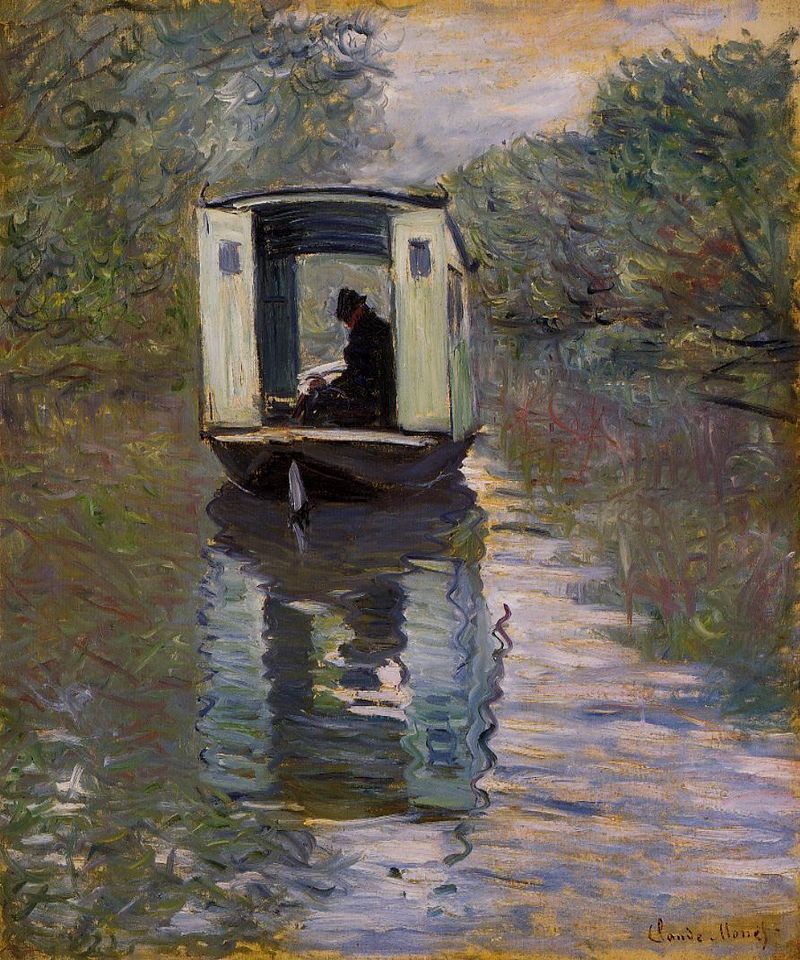 Claude Monet, Atelier sur Seine, (1876)
Claude Monet, Atelier sur Seine, (1876)
By 1875, Monet’s touch becomes very swift. The landscape almost engulfs the whole canvas and has enough motion emanating from its inexact brushstrokes that the figures are a part of the motion. This painting proves to many art historians that Monet was redefining the style of the Impressionist era. Impressionism initially was defined by isolating color, light, and movement. In the late 1870s, Monet had pioneered a style that combined all three, while maintaining a focus on the popular subjects of the Impressionist era. Artists were often so struck by Monet’s wispy brushstrokes that it was more than movement in his paintings, but a striking vibration.
Things that Create Movement in Art
- Lines pointing in one direction and spirals can create movement; diagonals, tilted elements, and things out of balance or unsupported will all give the feeling that movement is or is about to occur.

Theo van Doesburg, ‘Arithmetic Composition’ 1929This painting holds most of these examples true. The use of lines, diagonals, tilted elements, and things unsupported, Where are these elements found in this painting? When looking at this painting one can see that it seems like the same square is represented moving through space. Either getting smaller or larger. Not unlike the fractal art we looked at earlier in class. Self similar shapes being repeated smaller and smaller into time. Imagine if this painting was painted without the squares being on the diagonal? Would that change the feeling of movement?
Doesburg said of this painting ” It is as much the pyramid as the falling stone, as much the drake across the water as the Echo, it is as much time as space, the infinitely large as the infinitely small. - Fast-moving objects can be made to appear blurred, a little at the trailing edge or all over, depending on the speed and direction of motion (linear or rotational). Or, the subject may be relatively frozen in an instant while the background around it is blurred – in photography this is done by panning the camera to follow the subject while the exposure is made.

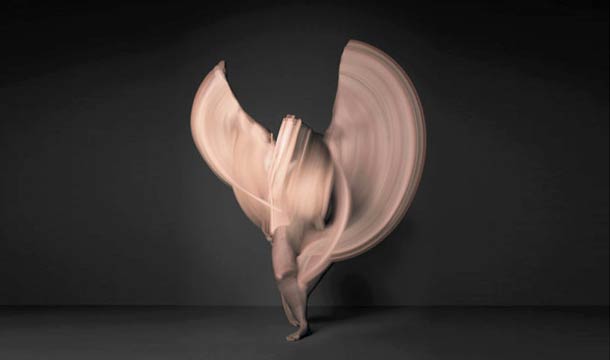
 Shinichi Maruyama Nude, photography & digital techniques, 2012In this series you can touch movement. Like it was a creamy substance, or an elaborate plaster sculpture. At least that’s how it seems by looking at the dancers in the series “Nude” by Japanese photographer Shinichi Maruyama, in collaboration with choreographer Jessica Lang.
Shinichi Maruyama Nude, photography & digital techniques, 2012In this series you can touch movement. Like it was a creamy substance, or an elaborate plaster sculpture. At least that’s how it seems by looking at the dancers in the series “Nude” by Japanese photographer Shinichi Maruyama, in collaboration with choreographer Jessica Lang.
Behind every image is the perfection of the human body. Bodies that are liquefied in time and movement.
Maruyama was introduced to photography by a teacher at his elementary school and experimented for years with the portrayal of movement, especially in water. With “Nude”, he takes the study of movement further, trying to refine it in relation to the unraveling of time and thus becomes the “painter of photography”. In this series he in fact uses much more elaborate techniques than in his previous works.
For “Nude”, each image is the digital synthesis of 10 thousand unique shots that compose the bodies of the dancers.
A century ago, scientists and photographers inspired many artists through photography methods that were able to take 12 shots a second. But with the current technology, Maruyama managed to capture 2 thousand photos a second and blend them into a kinetic cream through the use of new digital tools. - Placement can help show or frame motion. A moving subject placed in the first third of an image will have room to run. A moving subject placed in the last third may look like it’s about ready to hit the edge of the image: this placement is used if distance already traveled is of interest and could be emphasized to advantage. A moving subject that has already partially or mostly left the frame can show extreme speed, and/or the moment left in the wake of its passage.
 Roy Lichtenstein, Whaam!, 1963
Roy Lichtenstein, Whaam!, 1963
Whaam! depicts a fighter aircraft in the left panel firing a rocket into an enemy plane in the right panel, which disintegrates in a vivid red-and-yellow explosion. As you can see the fact that the plane is entering the composition leads us to believe that is will continue to move through the picture plane. The plane is partially off the canvas and is at a slant helping to support the feeling of movement.- Motion lines and afterimages can also be used to indicate motion – these techniques are common in graphic narrative works. Motion lines trail from near the back of the moving element in the direction of the path it has just traveled: the longer the lines, the more the motion and speed are emphasized.
Afterimages are the remembered or left-behind glimpses of something as it moves. A subject can be depicted in several places within the same picture, showing moments along the path of its passage as well as the passage of time. The afterimages can fade as they get further away from the present subject, and may only be the outlines of the front half of the subject in various poses it has gone through in moving: they can also get farther apart as they go back in time, and closer together as they approach the current instant. Afterimages can be used in conjunction with motion lines or on their own.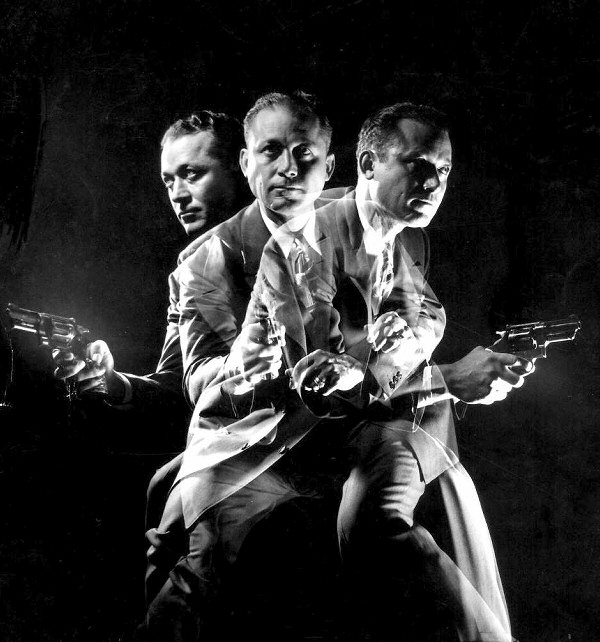 Gjon Mili, Stroboscopic image of FBI agent Del Bryce drawing his gun, 1945. Photography
Gjon Mili, Stroboscopic image of FBI agent Del Bryce drawing his gun, 1945. PhotographyThis photograph is an example of afterimages. Here are technically brilliant pictures that fiddle with moments, junctures, sequences, and in the process offer a playful commentary on the slippery relationship between mere mortals and the eternal.
 Example of motion lines. One can see that the lines in the image are made to represent motion.
Example of motion lines. One can see that the lines in the image are made to represent motion.
Kinetic Art
Videos and animations can show actual movement. Jewelry, ceramics and other three-dimensional work can have parts that are meant to be opened or otherwise moved, creating a physical engagement between the viewer and the work, and giving the viewer something to explore and discover. Artwork that moves by itself in part or in whole, powered by natural forces (wind, tide, light, etc.) or self-propelled, and in which the motion itself is used as an artistic element, is called kinetic art.
Kinetic Art is art from any medium that contains movement perceivable by the viewer or depends on motion for its effect. Canvas paintings that extend the viewer’s perspective of the artwork and incorporate multidimensional movement are the earliest examples of kinetic art. More pertinently speaking, kinetic art is a term that today most often refers to three-dimensional sculptures and figures such as mobiles that move naturally or are machine operated. The moving parts are generally powered by wind, a motor or the observer. Kinetic art encompasses a wide variety of overlapping techniques and styles.
Kinetic Rain – World’s largest kinetic art sculpture
The classic overbalanced wheel, AKA “perpetual motion machine”, as designed by a French architect in about 1235, and studied extensively by Leonardo Da Vinci in the late 1400’s.
The overbalanced wheel is the oldest attempt at a perpetual motion device in history. The oldest known description of one is from 8th century India.
The oldest surviving drawing of a perpetual motion machine was made by the French architect Villiard De Honnecourt in about 1235. He wrote:
“Many a time have skillful workmen tried to contrive a wheel that should turn of itself; here is a way to make such a one, by means of an uneven number of mallets.”
— Villiard De Honnecourt, 1235 AD
Leonardo DaVinci studied the concept in depth, and he also constructed several models – the models have not survived the ages, but dozens of his drawings have survived. Ultimately, he concluded that perpetual motion was indeed, impossible, and he abandoned the idea completely.